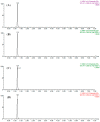Feasibility of Utilizing Stable-Isotope Dimethyl Labeling in Liquid Chromatography⁻Tandem Mass Spectrometry-Based Determination for Food Allergens-Case of Kiwifruit
- PMID: 31109069
- PMCID: PMC6571768
- DOI: 10.3390/molecules24101920
Feasibility of Utilizing Stable-Isotope Dimethyl Labeling in Liquid Chromatography⁻Tandem Mass Spectrometry-Based Determination for Food Allergens-Case of Kiwifruit
Abstract
Stable-isotope dimethyl labeling is a highly reactive and cost-effective derivatization procedure that could be utilized in proteomics analysis. In this study, a liquid chromatography- tandem mass spectrometry in multiple reaction monitoring mode (LC-MS-MRM) platform for the quantification of kiwi allergens was first developed using this strategy. Three signature peptides for target allergens Act d 1, Act d 5, and Act d 11 were determined and were derivatized with normal and deuterated formaldehyde as external calibrants and internal standards, respectively. The results showed that sample preparation with the phenol method provided comprehensive protein populations. Recoveries at four different levels ranging from 72.5-109.3% were achieved for the H-labeled signature peptides of Act d 1 (SPA1-H) and Act d 5 (SPA5-H) with precision ranging from 1.86-9.92%. The limit of quantification (LOQ) was set at 8 pg mL-1 for SPA1-H and at 8 ng mL-1 for SPA5-H. The developed procedure was utilized to analyze seven kinds of hand-made kiwi foods containing 0.0175-0.0515 mg g-1 of Act d 1 and 0.0252-0.0556 mg g-1 of Act d 5. This study extended the applicability of stable-isotope dimethyl labeling to the economical and precise determination of food allergens and peptides.
Keywords: food allergen; kiwifruit; liquid chromatography–tandem mass spectrometry; stable-isotope dimethyl labeling.
Conflict of interest statement
The authors declare no conflict of interest.
Figures






Similar articles
-
Quantification of the thaumatin-like kiwi allergen by a monoclonal antibody-based ELISA.Mol Nutr Food Res. 2008 Jun;52(6):701-7. doi: 10.1002/mnfr.200700286. Mol Nutr Food Res. 2008. PMID: 18384094
-
Comparison of allergen quantification strategies for egg, milk, and peanut in food using targeted LC-MS/MS.Anal Bioanal Chem. 2021 Sep;413(23):5755-5766. doi: 10.1007/s00216-021-03550-x. Epub 2021 Aug 3. Anal Bioanal Chem. 2021. PMID: 34341840
-
MRM3-based LC-MS multi-method for the detection and quantification of nut allergens.Anal Bioanal Chem. 2016 Nov;408(27):7845-7855. doi: 10.1007/s00216-016-9888-y. Epub 2016 Sep 2. Anal Bioanal Chem. 2016. PMID: 27590318
-
Targeted proteomics: Current status and future perspectives for quantification of food allergens.J Proteomics. 2016 Jun 30;143:15-23. doi: 10.1016/j.jprot.2016.04.018. Epub 2016 Apr 22. J Proteomics. 2016. PMID: 27113134 Free PMC article. Review.
-
Internal standards in the quantitative determination of protein biopharmaceuticals using liquid chromatography coupled to mass spectrometry.J Chromatogr B Analyt Technol Biomed Life Sci. 2012 Apr 15;893-894:1-14. doi: 10.1016/j.jchromb.2012.02.021. Epub 2012 Feb 21. J Chromatogr B Analyt Technol Biomed Life Sci. 2012. PMID: 22426285 Review.
Cited by
-
Isotopic Tracer for Absolute Quantification of Metabolites of the Pentose Phosphate Pathway in Bacteria.Metabolites. 2022 Nov 9;12(11):1085. doi: 10.3390/metabo12111085. Metabolites. 2022. PMID: 36355168 Free PMC article. Review.
-
Current Trends in Proteomic Advances for Food Allergen Analysis.Biology (Basel). 2020 Aug 25;9(9):247. doi: 10.3390/biology9090247. Biology (Basel). 2020. PMID: 32854310 Free PMC article. Review.
References
-
- Monaci L., Visconti A. Mass spectrometry-based proteomics methods for analysis of food allergens. TrAC Trends Anal. Chem. 2009;28:581–591. doi: 10.1016/j.trac.2009.02.013. - DOI
MeSH terms
Substances
Grants and funding
LinkOut - more resources
Full Text Sources

